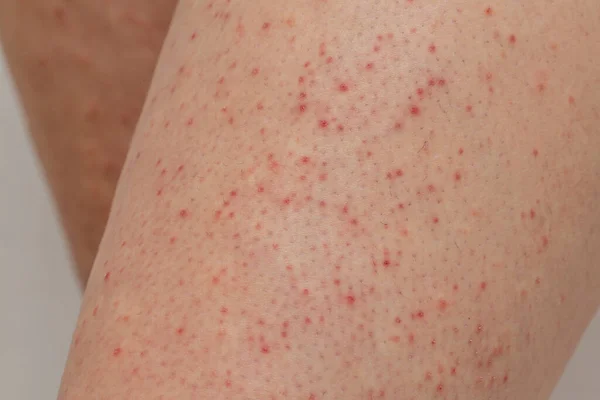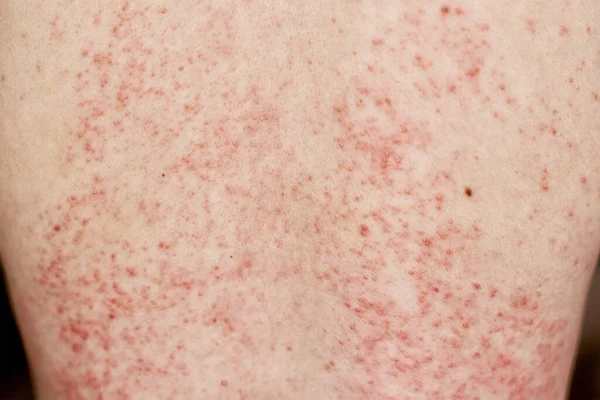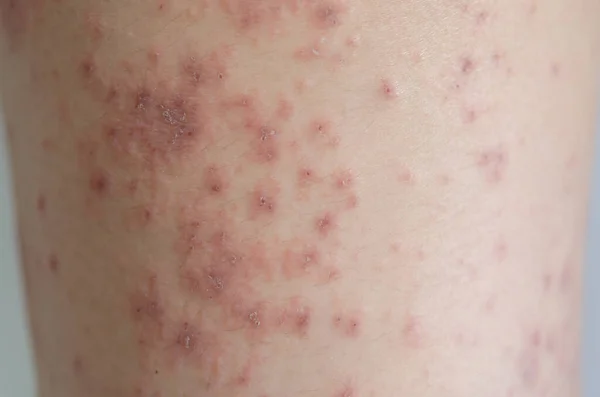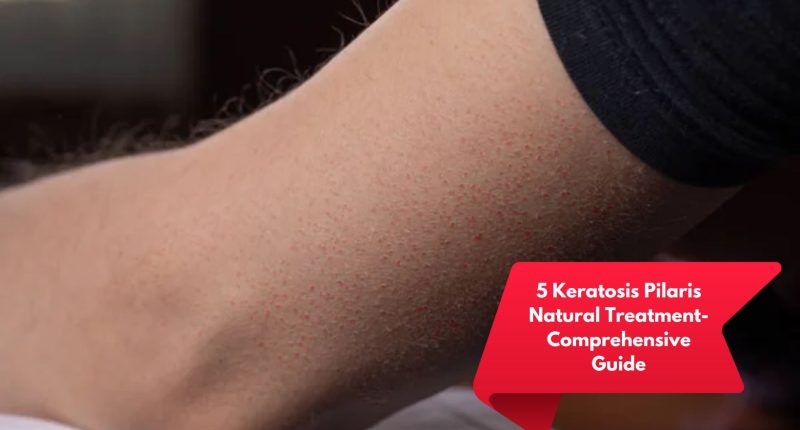In this comprehensive guide, we will delve into 5 Keratosis Pilaris Natural Treatment, shedding light on effective strategies to manage and alleviate this dermatological concern.
Keratosis Pilaris, often referred to as “chicken skin,” is a common skin condition characterized by small, red, or flesh-colored bumps on the skin’s surface. While it is generally harmless, the appearance of these bumps can be bothersome for many individuals.

Although keratosis pilaris is benign, if you’ve ever seen these tiny pimples on the backs of your legs, you know how annoying they can be. Thus, what causes these bumps to occur initially?
Dead skin cells clogging hair follicles is the source of this condition, which manifests as numerous pimples and bumps all over the skin. It typically appears on the buttocks, thighs, cheeks, and arms.
Similar in appearance to acne, keratosis pilaris is a common pore-clogging disorder that causes red and pink lumps. However, the affected area of keratosis pilaris frequently feels rough, dry, and akin to sandpaper. Although it might be irritating and itchy, it is usually not painful.
Keratosis Pilaris Symptoms
If you’ve noticed a few bumps, you may be wondering if keratosis pilaris is the cause.
If you’re unsure if the symptoms are indicative of keratosis pilaris or something else entirely, it’s usually a good idea to consult a doctor:
1. rough, red or pink skin
2. obstructed pores
3. Skin irritation
4. Scaly and dry skin
5. rough skin similar to sandpaper
6. Itchiness
Here is the 5 Keratosis Pilaris Natural Treatment;
1. Exfoliation With Alpha Hydroxy Acids
Keratosis Pilaris (KP) is a common skin condition that causes rough, bumpy patches, often on the upper arms, thighs, and buttocks. It’s caused by a buildup of keratin, a protein that forms hair and skin. While there’s no cure for KP, exfoliation with alpha hydroxy acids (AHAs) can help improve its appearance.
How AHAs Work for KP:
AHAs are a type of chemical exfoliant that gently dissolve the bonds that hold dead skin cells together, allowing them to be sloughed away. This helps to:
- Reduce the buildup of keratin: This can smooth out the rough bumps and patches associated with KP.
- Promote cell turnover: AHAs encourage the growth of new, healthy skin cells, which can further improve the texture of your skin.
- Exfoliate clogged pores: This can help to prevent ingrown hairs, which are a common problem for people with KP.
Types of AHAs for KP:
- Glycolic acid: This is the most common and effective AHA for KP. It’s a small molecule that can penetrate deep into the skin, making it more effective for treating KP. However, it can also be more irritating, especially for sensitive skin.
- Lactic acid: This is a larger molecule than glycolic acid, so it penetrates the skin less deeply. This makes it less irritating, but also less effective for treating KP. However, it can be a good option for people with sensitive skin.
- Mandelic acid: This is a gentle AHA that’s even less irritating than lactic acid. It’s a good option for people with very sensitive skin, but it may not be as effective as glycolic acid or lactic acid for treating KP.
How to use AHAs for KP:
- Start with a low concentration of AHA: If you’re new to AHAs, it’s best to start with a product that contains 5% or less AHA. You can gradually increase the concentration as your skin gets used to it.
- Use AHAs only on affected areas: Apply AHAs to the areas where you have KP, such as your arms, thighs, and buttocks. Avoid using them on your face or neck, as these areas are more sensitive.
- Patch test first: Before you use any new AHA product, do a patch test on a small area of your skin to make sure you don’t have an allergic reaction.
- Moisturize: AHAs can be drying, so it’s important to moisturize your skin regularly, especially after using AHAs.
Here are some additional tips for using AHAs for KP:
- Be patient: It may take several weeks to see results from using AHAs.
- Don’t scrub: Scrubbing can irritate your skin and make KP worse.
- Avoid sun exposure: AHAs can make your skin more sensitive to the sun, so be sure to wear sunscreen every day, even if it’s cloudy.
2. Coconut Oil Moisturization
Coconut oil is a popular natural remedy for dry skin, and many people with keratosis pilaris (KP) find it helpful for moisturizing their rough, bumpy patches. Here’s what you need to know about using coconut oil for KP:
Benefits of Coconut Oil for KP:
- Moisturizing: Coconut oil is rich in fatty acids, which help to hydrate and nourish the skin. This can be especially helpful for people with KP, who often have dry skin.
- Anti-inflammatory: Coconut oil has some anti-inflammatory properties, which may help to reduce the redness and irritation associated with KP.
- Antibacterial: Coconut oil has some antibacterial properties, which may help to prevent infections in the hair follicles around the KP bumps.
How to Use Coconut Oil for KP:
- Choose the right coconut oil: Look for extra-virgin coconut oil that is cold-pressed and unrefined. This type of coconut oil is the least processed and contains the most beneficial nutrients.
- Apply to clean, damp skin: After showering or bathing, pat your skin dry and apply a thin layer of coconut oil to the affected areas.
- Massage gently: Massage the coconut oil into your skin in a circular motion.
- Use once or twice a day: You can use coconut oil once or twice a day, depending on your skin’s needs.
Things to Keep in Mind:
- Coconut oil is comedogenic: This means that it can clog pores, so it’s not suitable for everyone. If you have oily or acne-prone skin, you may want to avoid using coconut oil on your face.
- Patch test first: Before applying coconut oil to a large area of your skin, do a patch test on a small area first to make sure you don’t have an allergic reaction.
- Don’t expect a miracle cure: Coconut oil is not a cure for KP, but it can help to improve the appearance of your skin. Be patient and consistent with your treatment, and you may see some results within a few weeks.

3. Topical Retinoids For Cell Turnover
Topical retinoids are not traditionally considered “natural” treatments, as they are synthetic vitamin A derivatives. However, they can be a very effective option for promoting cell turnover and improving the appearance of keratosis pilaris (KP). Here’s what you need to know:
How Topical Retinoids Work for KP:
- Promote cell turnover: Retinoids encourage the shedding of dead skin cells and stimulate the growth of new, healthy ones. This can help to prevent the buildup of keratin that causes the rough bumps and patches associated with KP.
- Exfoliate clogged pores: Retinoids can also help to unclog pores and prevent ingrown hairs, which are common issues for people with KP.
- Reduce inflammation: Some retinoids have anti-inflammatory properties, which can help to soothe redness and irritation associated with KP.
Types of Topical Retinoids for KP:
- Adapalene (Differin): This over-the-counter retinoid is a good option for mild to moderate KP. It’s relatively gentle and less irritating than some other retinoids.
- Tretinoin (Retin-A): This prescription retinoid is more potent than adapalene and may be a better option for moderate to severe KP. However, it can be more irritating and is more likely to cause side effects.
- Tazarotene (Tazorac): Another prescription retinoid, tazarotene can be effective for both KP and acne. It’s also available in a cream and a lotion formulation, which can be helpful for people with dry skin.
How to Use Topical Retinoids for KP:
- Start slowly: Start by applying a small amount of the retinoid to the affected area once a week. Gradually increase the frequency of application to every other day, then every day as your skin can tolerate it.
- Moisturize: Retinoids can be drying, so it’s important to moisturize your skin regularly, especially after using them.
- Use sunscreen: Retinoids can make your skin more sensitive to the sun, so be sure to wear sunscreen every day, even if it’s cloudy.
- Talk to your doctor: If you have any concerns about using topical retinoids, talk to your doctor or dermatologist. They can help you choose the right retinoid for your skin and give you guidance on how to use it safely and effectively.
Things to Keep in Mind:
- Don’t expect instant results: It may take several weeks to see results from using topical retinoids.
- Retinoids can be irritating: Retinoids can cause dryness, redness, peeling, and stinging. If you experience any side effects that are severe or bothersome, stop using the retinoid and talk to your doctor.
- Retinoids are not suitable for everyone: Pregnant or breastfeeding women and people with certain skin conditions should not use topical retinoids.
4. Oatmeal Baths For Soothing Relief
Oatmeal baths are a gentle and effective way to soothe the itch and irritation associated with keratosis pilaris (KP). The colloidal oatmeal in the bathwater has several properties that make it beneficial for KP:
1. Soothing and anti-inflammatory: Oatmeal contains avenanthramides, which have anti-inflammatory and antioxidant properties. These can help to reduce redness, itching, and irritation associated with KP.
2. Moisturizing: Oatmeal is a natural humectant, which means it attracts and retains moisture. This can help to hydrate dry, flaky skin that is often a symptom of KP.
3. Protective: Oatmeal forms a protective barrier on the skin that can help to prevent further irritation from scratching or rubbing.
4. Gentle exfoliation: The fine particles of colloidal oatmeal can gently exfoliate the skin, helping to remove dead skin cells and prevent clogged pores.
How to take an oatmeal bath for KP:
- Grind up regular oatmeal in a blender or food processor until it is a fine powder. You can also purchase pre-ground colloidal oatmeal at most drugstores.
- Add 1/2 cup to 1 cup of colloidal oatmeal to a warm bath.
- Soak in the bath for 15-20 minutes.
- Gently pat your skin dry with a towel, do not rub.
- Apply a fragrance-free moisturizer to help lock in moisture.
Tips:
- You can repeat this process 2-3 times per week.
- Consider adding other soothing ingredients to your bath, such as baking soda, Epsom salts, or lavender oil.
- Make sure the water is not too hot, as this can dry out your skin.
- Be patient! It may take a few weeks to see results from oatmeal baths.
Here are some additional natural treatments that you can try for KP:
- Alpha hydroxy acids (AHAs): AHAs, such as glycolic acid or lactic acid, can help to exfoliate the skin and remove dead skin cells.
- Salicylic acid: Salicylic acid is a beta hydroxy acid (BHA) that can help to unclog pores and prevent ingrown hairs.
- Coconut oil: Coconut oil is a natural moisturizer that can help to hydrate and soothe the skin.
- Shea butter: Shea butter is another natural moisturizer that can help to nourish and protect the skin.
It is important to talk to your doctor or dermatologist before using any new products on your skin, especially if you have sensitive skin or any other skin conditions.

5. Dietary Adjustments and Omega-3 Fatty Acids
While there’s no cure for keratosis pilaris (KP), making certain dietary adjustments and incorporating omega-3 fatty acids can significantly improve the appearance and reduce the discomfort associated with this skin condition. Here’s a closer look:
Dietary Adjustments:
1. Reduce Inflammatory Foods:
- Limit dairy: Some people with KP find their symptoms worsen with dairy consumption. Consider reducing or eliminating dairy products like milk, cheese, and yogurt for a trial period to see if you notice any improvement.
- Cut back on gluten: While not everyone with KP is gluten-sensitive, some individuals report improvement in their KP after eliminating gluten from their diet. If you suspect gluten sensitivity, consult a healthcare professional for testing.
- Minimize processed foods: Processed foods are often high in unhealthy fats, refined sugars, and additives, which can contribute to inflammation and worsen KP symptoms. Focus on whole, unprocessed foods like fruits, vegetables, lean protein, and whole grains.
- Limit sugar and refined carbohydrates: Sugary drinks, pastries, and white bread can spike blood sugar levels and contribute to inflammation. Opt for complex carbohydrates like brown rice, quinoa, and sweet potatoes instead.
2. Increase Anti-Inflammatory Foods:
- Load up on fruits and vegetables: These are packed with antioxidants and vitamins that can help reduce inflammation and support overall skin health. Aim for a variety of colorful fruits and vegetables daily.
- Choose healthy fats: Omega-3 fatty acids found in fatty fish, flaxseeds, chia seeds, and walnuts have anti-inflammatory properties and can benefit your skin health.
- Incorporate probiotics: Probiotics, found in fermented foods like yogurt, kimchi, and sauerkraut, can help improve gut health and reduce inflammation, which may indirectly benefit KP.
Omega-3 Fatty Acids:
Omega-3 fatty acids, particularly EPA and DHA, are essential for skin health and play a crucial role in reducing inflammation. They can help:
- Decrease inflammation: Omega-3s can help calm the inflammatory response in the body, potentially reducing the redness and irritation associated with KP.
- Improve skin barrier function: Omega-3s can help strengthen the skin’s barrier, making it less susceptible to irritation and dryness.
- Promote cell turnover: Omega-3s can stimulate the production of new skin cells, helping to shed dead skin cells that contribute to the rough bumps of KP.
Food Sources of Omega-3s:
- Fatty fish: Salmon, tuna, mackerel, sardines, and herring are excellent sources of EPA and DHA. Aim for at least two servings per week.
- Flaxseeds and chia seeds: These tiny seeds are rich in plant-based omega-3s called ALA. Grind them before consuming to increase their absorption.
- Walnuts and hemp seeds: These nuts and seeds are also good sources of ALA. Include them in your snacks, salads, or yogurt bowls.
- Algae oil: This is a vegan source of EPA and DHA, making it a good option for those who don’t eat fish.
Supplements:
If you aren’t getting enough omega-3s from your diet, consider taking a supplement. Look for a high-quality fish oil or algae oil supplement that contains at least 1,000 mg of EPA and DHA per day.
Remember:
- Consult your doctor before starting any new supplements, especially if you have any existing health conditions or take medications.
- Dietary changes and omega-3 supplementation may take several weeks to show noticeable results. Be patient and consistent with your approach.
- Combining dietary adjustments with other topical treatments or skincare practices may further improve your KP.
By making mindful dietary adjustments and incorporating omega-3 fatty acids into your routine, you can manage your KP and achieve smoother, healthier-looking skin.
What Experts Says
While keratosis pilaris (KP) has no known cure, several natural treatment options can help manage its symptoms and improve the appearance of your skin. Here’s what some leading dermatologists have to say about popular natural remedies for KP:
1. Dr. Paradi Mirmirani, board-certified dermatologist:
- On oatmeal baths: “Oatmeal baths are a great way to soothe the itch and irritation associated with KP. The colloidal oatmeal in the bathwater has anti-inflammatory and moisturizing properties that can help calm the skin.”
- On coconut oil: “Coconut oil can be a good moisturizer for dry skin, but it can also clog pores for some people. If you’re going to use it, be sure to choose a fractionated coconut oil, which is less likely to cause breakouts.”
2. Dr. Jessica Wu, board-certified dermatologist:
- On alpha hydroxy acids (AHAs): “AHAs like glycolic acid and lactic acid can help to gently exfoliate the skin and remove dead skin cells that contribute to the rough bumps of KP. However, they can also be irritating, so it’s important to start with a low concentration and use them gradually.”
- On salicylic acid: “Salicylic acid is another type of exfoliant that can be helpful for KP. It can help to unclog pores and prevent ingrown hairs.”
3. Dr. Joshua Zeichner, board-certified dermatologist:
- On dietary adjustments: “While there’s no specific KP diet, some people find that their symptoms improve when they avoid dairy products or processed foods. Eating a healthy diet rich in fruits, vegetables, and omega-3 fatty acids can also be beneficial for overall skin health.”
- On omega-3 fatty acids: “Omega-3 fatty acids have anti-inflammatory properties that can help to reduce the redness and irritation associated with KP. They can be found in fatty fish, flaxseeds, chia seeds, and walnuts.”
Takeaway
In this comprehensive guide to 5 Keratosis Pilaris Natural Treatment, we’ve navigated through the realms of exfoliation, moisturization, dietary adjustments, topical remedies, and the judicious use of sun exposure.
By incorporating these natural treatments into your skincare routine, you embark on a journey towards smoother, healthier skin, embracing the transformative power of nature. Remember, consistency is key, and results may vary from person to person. Consult with a dermatologist for personalized advice tailored to your unique skin needs.
Also Read: Understanding 3 Different Types Of Labiaplasty Techniques: Everything You Should Know
Note: This article is written based on scientific evidence found by the 247newsaroundtheworld.com team. Sources are duly referenced with keywords hyperlinked to source websites and are clickable for reference.






